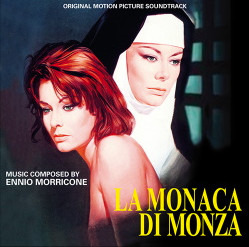主页--->m-comment-000--->mb-comment-006-68
|
电脑版 |
|||||||||||||||||
布罗克斯顿评说莫里康内 MB-006-68 |
||||||||||||||||||
FA6815 La monaca di Monza
/ The Lady of Monza / 深院偷情 / 蒙扎的修女 |
||||||||||||||||||
作者 乔纳森·布罗克斯顿 (Jonathan Broxton) |
||||||||||||||||||
ENNIO MORRICONE 评论,第6部分 006-68 |
||||||||||||||||||
 |
||||||||||||||||||
LA MONACA DI MONZA [蒙扎夫人] (1968) 《蒙扎的莫纳卡》是一部意大利剧情片,由导演埃里普兰多·维斯康蒂执导,改编自亚历山德罗·曼佐尼 1840 年的著名小说《I Promessi Sposi》。它松散地基于玛丽安娜·德·莱瓦(Marianna de Leyva)的真实生活事件,她更广为人知的是“蒙扎修女”,她是 16 世纪意大利耸人听闻丑闻的主要参与者,当时她生下了两个当地贵族的孩子,并安排谋杀了另一名修女以掩盖这件事。这部电影由安妮·海伍德饰演莱瓦,哈迪·克鲁格饰演她的修道院院长阿里戈内神父,安东尼奥·萨巴托饰演的贵族詹帕洛。 莫里康内为这部电影的配乐是围绕他最令人难以忘怀的主题之一“La Monaca di Monza”构建的,它建立在开场“Titoli”中一些令人毛骨悚然的场景设置之上,成为深沉、郁郁葱葱但听起来略带扭曲的中提琴旋律,以紧张的钢琴和弦、弦乐和大键琴为基础。这是一个想要狂喜浪漫的主题,但从未完全实现,被莱瓦的诡计多端所阻碍。同样的旋律被安排为一段礼仪合唱音乐,为女歌手“Gloria in Excelsis Deo”,然后在第二和第三“La Monaca di Monza”提示中进一步扩展,这些提示对他们来说具有更悲惨的声音,再次以哭泣的中提琴和大提琴为特色。 其他值得注意的线索包括令人陶醉但奇怪的令人不安的“Svegliarsi Pensando”,它使用与主旋律相同的器乐织体,但带有不同的旋律,以及更具传统吸引力的“Falsa Tranquillitá”,它最初使用突出的竖琴来传达稍微温暖和吸引人的音色,然后在郁郁葱葱的结局中变得相当广阔。 “Quel Giorno”非常有力,带有一丝巴洛克风格(Baroque flavored music)的动作音乐,代表了莱瓦在西班牙宗教裁判所的追捕者,而两个“Dopo la Notte”提示则以主旋律的变奏为特色,为这对夫妇命运多舛和受孕的孩子提供了一个可爱的田园主题。在最后的“Titoli di Coda”中,让他所有的旋律都以最温柔的方式演唱,让它们传达蒙扎修女一生中短暂的浪漫但最终的悲剧。 这里回顾的 La Monaca di Monza 版本是 Quartet Records 于 2014 年发行的版本,搭配另一首美丽的莫里康内浪漫乐谱 La Califfa。该节目比 Point Records 的上一张专辑扩展了 7 分钟,该专辑于90年代初发行,现在很难找到,绝对推荐给莫里康内礼仪风格的粉丝。 曲目列表: 1. La Monaca di Monza (Titoli) (2:35), 2.La Monaca di Monza (Gloria in Excelsis Deo) (0:58), 3.Svegliarsi Pensando (0:56), 4.Falsa Tranquillitá (3:04), 5.Notte Non Notte (1:27), 6.奎尔·乔尔诺 (2:00), 7.Dopo la Notte (1:34), 8.La Monaca di Monza # 2 (0:43), 9.La Monaca di Monza # 3 (2:13), 10.Dopo la Notte #2 (1:10), 11.Svegliarsi Pensando # 2 (1:42), 12.Canone per quattro (0:57), 13.Titoli di Coda (2:27).四重奏记录QR-156,21分46秒。 |
||||||||||||||||||
2020.9.19 |
||||||||||||||||||
|
| ||||||||||||||||||
以下是原文
| ||||||||||||||||||
ENNIO MORRICONE REVIEWS, Part 6-68 |
||||||||||||||||||
LA MONACA DI MONZA [THE LADY OF MONZA] (1968) La Monaca di Monza is an Italian drama film from director Eriprando Visconti, based on the famous 1840 novel ‘I Promessi Sposi’ by Alessandro Manzoni. It is loosely based on the real life events of Marianna de Leyva, better known as “The Nun of Monza,” who was a main player in lurid scandal in 16th century Italy when she gave birth to two children fathered by a local aristocrat, and arranged for the murder of another nun in order to cover up the affair. The film stars Anne Heywood as Leyva, Hardy Krüger as the head of her convent Father Arrigone, and Antonio Sabàto as the lascivious aristocrat Giampaolo. Morricone’s score for the film is built around one of his most haunting main themes, “La Monaca di Monza,” which builds out of some eerie scene-setting in the opening ‘Titoli’ to become a deep, lush, but slightly twisted-sounding viola melody underpinned with nervous piano chords, strings, and a harpsichord. It’s a theme which wants to be rapturously romantic, but never quite gets there, held back by Leyva’s scheming nature. The same melody is arranged as a piece of liturgical choral music for a cut-glass female vocalist ion “Gloria in Excelsis Deo” is then expanded further in the second and third “La Monaca di Monza” cues, which have a more tragic sound to them, again featuring weeping violas and cellos. Other cues of note include the swooning, but oddly unsettling “Svegliarsi Pensando,” which uses the same instrumental textures as the main theme but carries a different melody, and the more conventionally attractive “Falsa Tranquillitá,” which initially uses a prominent harp to convey a slightly more warm and appealing tone, and then becomes quite expansive during its lush and sweeping finale. “Quel Giorno” is quite forceful, with a touch of Baroque-flavored (action music to represent Leyva’s pursuers from the Spanish Inquisition, while the two “Dopo la Notte” cues feature a variation on the main melody that acts as a lovely pastoral theme for the couple’s ill-fated and ill-conceived child. Finally, in the conclusive “Titoli di Coda,” lets all his melodies sing at their most tender, allowing them to convey the brief romance but ultimate tragedy of the nun of Monza’s life. The version of La Monaca di Monza reviewed here is the one released by Quartet Records in 2014, paired with another beautiful Morricone romance score La Califfa. The program expands by seven minutes the previous release by Point Records, which was issued in the early nineties and now hard-to-find, and is absolutely recommended to fans of Morricone’s liturgical style. Track Listing: 1. La Monaca di Monza (Titoli) (2:35), 2. La Monaca di Monza (Gloria in Excelsis Deo) (0:58), 3. Svegliarsi Pensando (0:56), 4. Falsa Tranquillitá (3:04), 5. Notte Non Notte (1:27), 6. Quel Giorno (2:00), 7. Dopo la Notte (1:34), 8. La Monaca di Monza # 2 (0:43), 9. La Monaca di Monza # 3 (2:13), 10. Dopo la Notte # 2 (1:10), 11. Svegliarsi Pensando # 2 (1:42), 12. Canone Per Quattro (0:57), 13. Titoli di Coda (2:27). Quartet Records QR-156, 21 minutes 46 seconds. |
||||||||||||||||||
Sep 19, 2020 |
||||||||||||||||||
本站电影欣赏 |
||||||||||||||||||
在线音乐试听 |
||||||||||||||||||
 |
||||||||||||||||||
Jon 是一位电影音乐评论家和记者,自 1997 年以来一直担任全球最受欢迎的英语电影音乐网站之一 Movie Music UK 的编辑和首席评论员,并且是国际电影音乐评论家协会 (IFMCA) 的主席。在过去的 20多 年中,Jon 撰写了 3,000 多篇评论和文章,并进行了多次作曲家采访。在杂志刊物方面,乔恩曾为《电影配乐月刊》、《原声带杂志》和《电影音乐》等出版物撰写评论和文章,并为普罗米修斯唱片公司的两张经典 Basil Poledouris 配乐专辑《Amanda》和《Flyers / Fire on the Mountain》撰写了衬垫注释。他还为汤姆·胡佛 (Tom Hoover) 于 2011 年出版的《Soundtrack Nation: Interviews with Today's Top Professionals in Film, Videogame, and Television Scorering》一书撰写了一章。在1990年代后期,乔恩是伦敦皇家爱乐乐团的电影音乐顾问,并与他们合作拍摄了约翰·德布尼(John Debney)的音乐电影《相对价值》(Relative Values)和奥利弗·海斯(Oliver Heise)的音乐《佛陀的指环》(The Ring of the Buddha),以及与兰迪·纽曼(Randy Newman)合作的一系列音乐会。2012年,乔恩在波兰克拉科夫举行的第五届年度电影音乐节上担任“电影节学院”主席。他是作曲家和作词家协会的成员,该协会是作曲家、作词家和词曲作者从事电影、电视和多媒体工作的首要非营利组织。 |
||||||||||||||||||
2023.12.1 |
||||||||||||||||||
2023 手机版 |
||||||||||||||||||
|
||||||||||||||||||













